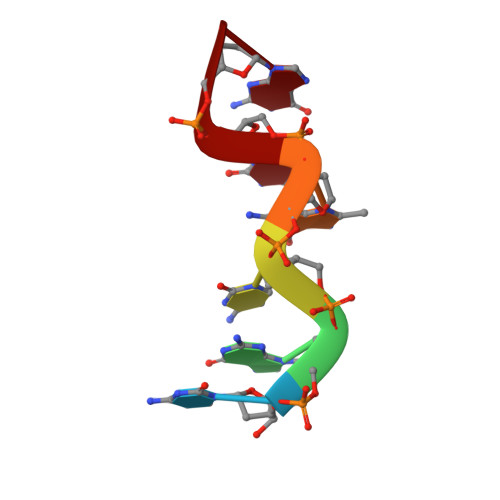Synthesis, structure and thermodynamic properties of 8-methylguanine-containing oligonucleotides: Z-DNA under physiological salt conditions.
Sugiyama, H., Kawai, K., Matsunaga, A., Fujimoto, K., Saito, I., Robinson, H., Wang, A.H.(1996) Nucleic Acids Res 24: 1272-1278
- PubMed: 8614630
- DOI: https://doi.org/10.1093/nar/24.7.1272
- Primary Citation of Related Structures:
1TNE - PubMed Abstract:
Various oligonucleotides containing 8-methylguanine (m8G) have been synthesized and their structures and thermodynamic properties investigated. Introduction Of M8G into DNA sequences markedly stabilizes the Z conformation under low salt conditions. The hexamer d(CGC[M8G]CG)2 exhibits a CD spectrum characteristic of the Z conformation under physiological salt conditions. The NOE-restrained refinement unequivocally demonstrated that d(CGC[m8G]CG)2 adopts a Z structure with all guanines in the syn conformation. The refined NMR structure is very similar to the Z form crystal structure of d(CGCGCG)2, with a root mean square deviation of 0.6 between the two structures. The contribution of m8G to the stabilization of Z-DNA has been estimated from the mid-point NaCl concentrations for the B-Z transition of various m8G-containing oligomers. The presence of m8G in d(CGC[m8G]CG)2 stabilizes the Z conformation by at least deltaG = -0.8 kcal/mol relative to the unmodified hexamer. The Z conformation was further stabilized by increasing the number of m8Gs incorporated and destabilized by incorporating syn-A or syn-T, found respectively in the (A,T)-containing alternating and non-alternating pyrimidine-purine sequences. The results suggest that the chemically less reactive m8G base is a useful agent for studying molecular interactions of Z-DNA or other DNA structures that incorporate syn-G conformation.
Organizational Affiliation:
Department of Synthetic Chemistry and Biological Chemistry, Faculty of Engineering, Kyoto University, Japan.













